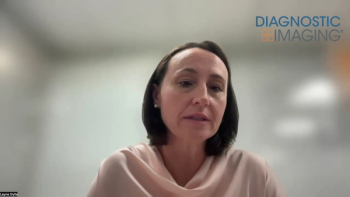
“No Dose” Scans Equally Effective in ID’ing COVID-19 Traits
Side-by-side images show lung ultrasound pinpoints same findings as low-dose chest CT.
Radiologists can potentially avoid exposing patients suspected of COVID-19 infection to unnecessary radiation. New images reveal findings from a lung ultrasound correlated closely with those of a chest CT.
Published in
The images came from a 54-year-old man who presented to Hôpital Nord in Marseille, France, with fever, cough, and shortness of breath that had lasted for four days. Both a low-dose chest CT and the RT-PCR test were conducted, resulting in a positive COVID-19 diagnosis. Providers completed a lung ultrasound, as well, after he was admitted to the intensive care unit due to oxygenation failure.
When compared the lung ultrasound and chest CT both reveal similar areas of pulmonary involvement and the pattern of parenchymal disease.
The transverse thoracic CT image shows multi-lobar asymmetric lung lesions with peripheral distribution of ground-glass opacities, consolidation, and crazy pavement pattern. The lung ultrasound images (shown as thumbnails alongside the CT scan) indicate the corresponding areas of A lines (normal aeration pattern), focal and confluent B lines (interstitial pattern), and thickening and irregularity of the pleural line in associated with B line that suggests primary lung injury.
“Lung ultrasonography may be considered a useful alternative to low-dose chest CT for diagnosis and management of COVID-19 given its ease of use, repeatability, reproducibility, absence of radiation, and immediate bedside application that obviates the need to transport the critically ill patient to the CT scanner,” said corresponding author Gary Duclos.
Newsletter
Stay at the forefront of radiology with the Diagnostic Imaging newsletter, delivering the latest news, clinical insights, and imaging advancements for today’s radiologists.



























